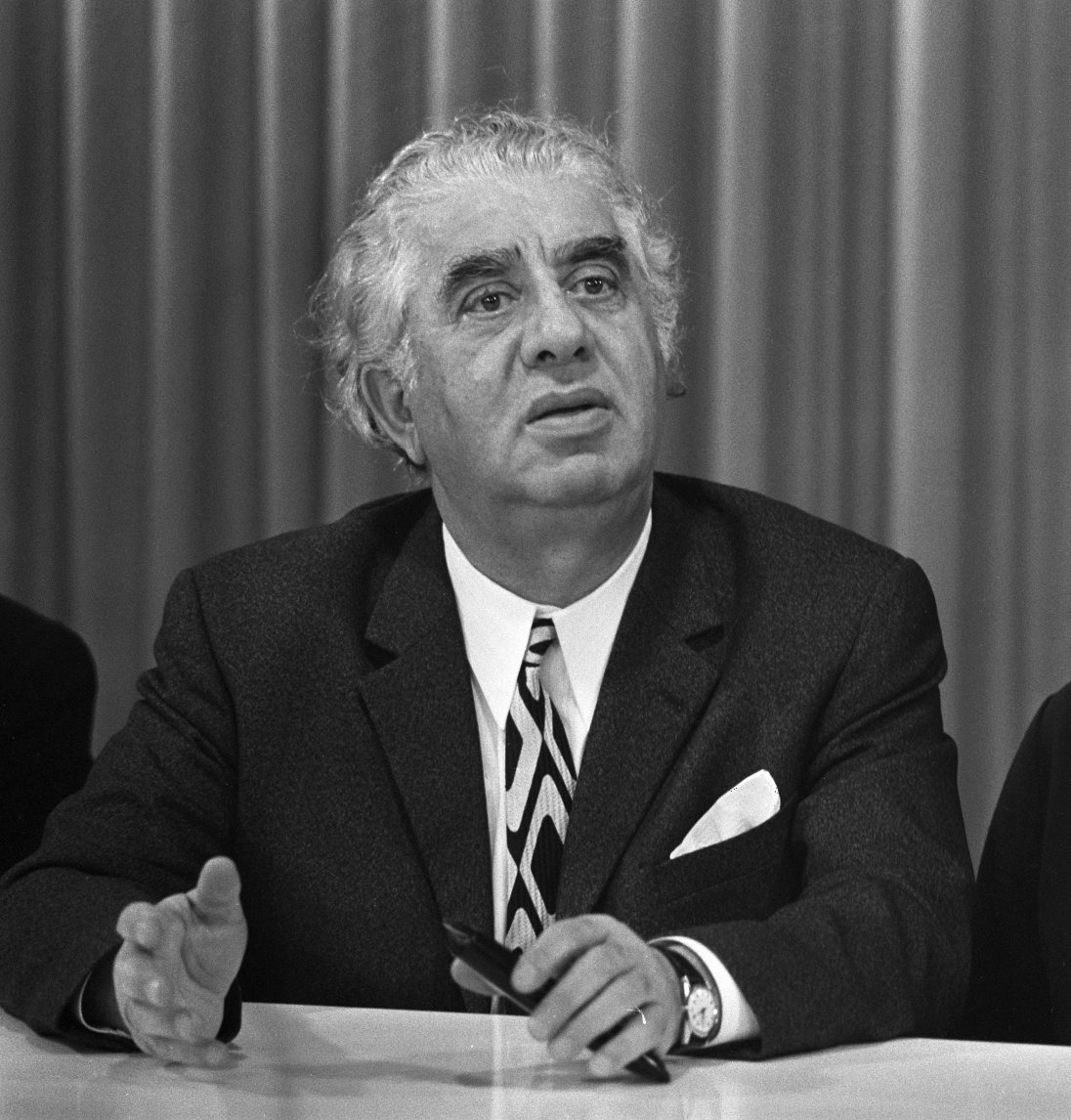
Aram Khachaturian
Aram Ilyich Khachaturian (; 6 June [O.S. 24 May] 1903 – 1 May 1978) was a Soviet Armenian composer and conductor. He is considered one of the leading Soviet composers. Born and raised in Tbilisi (now the capital of Georgia), he moved to Moscow in 1921 following the Sovietization of the Caucasus. Without prior music training, he enrolled in the Gnessin Musical Institute, and subsequently studied at the Moscow Conservatory in the class of Nikolai Myaskovsky, among others. His first major work, the Piano Concerto (1936), popularized his name within and outside the Soviet Union. It was followed by the Violin Concerto (1940) and the Cello Concerto (1946). His other significant compositions include the Masquerade Suite (1941), the Anthem of the Armenian SSR (1944), three symphonies (1935, 1943, 1947), and around 25 film scores. Khachaturian is best known for his ballet music: Gayane (1942) and Spartacus (1954). His most popular piece, the "Sabre Dance" from Gayane, has been used extensively in popular culture and has been performed by a number of musicians worldwide. His style is "characterized by colorful harmonies, captivating rhythms, virtuosity, improvisations, and sensuous melodies". During most of his career, Khachaturian was approved by the Soviet government and held several high posts in the Union of Soviet Composers from the late 1930s, although he joined the Communist Party only in 1943. Along with Sergei Prokofiev and Dmitri Shostakovich, he was officially denounced as a "formalist" and his music dubbed "anti-people" in 1948 but was restored later that year. After 1950 he taught at the Gnessin Institute and the Moscow Conservatory and turned to conducting. He traveled to Europe, Latin America, and the United States with concerts of his own works. In 1957 Khachaturian became the Secretary of the Union of Soviet Composers, a position he held until his death. Khachaturian composed the first Armenian ballet music, symphony, concerto, and film score. He is considered the most renowned Armenian composer of the 20th century. While following the established musical traditions of Russia, he broadly incorporated Armenian and, to a lesser extent, Caucasian, Eastern and Central European, and Middle Eastern peoples' folk music into his works. He is highly regarded in Armenia, where he is considered a "national treasure". |
Birth and Death Data: Born Tbilisi (capital and the largest city of Georgia (country)) , Died May 1, 1978 (Moscow (capital and most populous city of Russia) )
Date Range of DAHR Recordings: 1947 - 1950
Roles Represented in DAHR: composer
 = Recordings are available for online listening.
= Recordings are available for online listening.
 = Recordings were issued from this master. No recordings issued from other masters.
= Recordings were issued from this master. No recordings issued from other masters.
Recordings
| Company | Matrix No. | Size | First Recording Date | Title | Primary Performer | Description | Role | Audio |
|---|---|---|---|---|---|---|---|---|
| Victor | E0VB-5629 | 10-in. | 9/15/1950 | Sabre dance | Dick Contino | Instrumental ensemble | composer | |
| Victor | D7VB-2131 | 10-in. | 11/26/1947 | Sabre dance boogie | Barclay Allen ; Freddy Martin Orchestra | Instrumental ensemble, with piano solo | composer | |
| Victor | D7RC-6877 | 12-in. | 11/18/1947 | Gayne, ballet suite, part 1 | Chicago Symphony Orchestra ; Artur Rodzinski | Orchestra | composer | |
| Victor | D7RC-6878 | 12-in. | 11/18/1947 | Gayne, ballet suite, part 2 | Chicago Symphony Orchestra ; Artur Rodzinski | Orchestra | composer | |
| Victor | D7RC-6880 | 12-in. | 11/18/1947 | Gayne, ballet suite, part 4 | Chicago Symphony Orchestra ; Artur Rodzinski | Orchestra | composer | |
| Victor | D7RC-7600 | 12-in. | 6/18/1947 | Masquerade (Symphonic suite), part 1 | Boston Pops Orchestra ; Arthur Fiedler | Orchestra | composer | |
| Victor | D7RC-7601 | 12-in. | 6/18/1947 | Masquerade (Symphonic suite), part 2 | Boston Pops Orchestra ; Arthur Fiedler | Orchestra | composer | |
| Victor | D7RC-7602 | 12-in. | 6/18/1947 | Masquerade (Symphonic suite), part 3 | Boston Pops Orchestra ; Arthur Fiedler ; Alfred Krips | Violin solo, with orchestra | composer | |
| Victor | D7RC-7603 | 12-in. | 6/18/1947 | Masquerade (Symphonic suite), part 4 | Boston Pops Orchestra ; Arthur Fiedler | Orchestra | composer |
Citation
Discography of American Historical Recordings, s.v. "Khachaturian, Aram," accessed January 21, 2026, http://adp.library.ucsb.edu/names/362293.
Khachaturian, Aram. (2026). In Discography of American Historical Recordings. Retrieved January 21, 2026, from http://adp.library.ucsb.edu/names/362293.
"Khachaturian, Aram." Discography of American Historical Recordings. UC Santa Barbara Library, 2026. Web. 21 January 2026.
DAHR Persistent Identifier
External Sources
Wikipedia: Արամ Խաչատրյան
Discogs: Aram Khachaturian
Allmusic: Aram Khachaturian
Apple Music: Aram Khachaturian
Grove: Aram Khachaturian
IMSLP: Aram Khachaturian
RILM: Aram Khachaturian
RISM: Aram Khachaturian
IMDb: Aram Khachaturian
Britannica: Aram Khachaturian
Linked Open Data Sources
LCNAR: Khachaturi︠a︡n, Aram, 1903-1978 - https://id.loc.gov/authorities/names/n81059831
Wikidata: Արամ Խաչատրյան - https://www.wikidata.org/entity/Q152293
VIAF: https://viaf.org/viaf/19865761
MusicBrainz: Արամ Խաչատրյան - https://musicbrainz.org/artist/fa25cd1f-beeb-4718-b4bb-d3da4f53539f
Fast: https://id.worldcat.org/fast/73505 - https://id.worldcat.org/fast/73505
Wikipedia content provided under the terms of the Creative Commons BY-SA license
Feedback
Send the Editors a message about this record.
